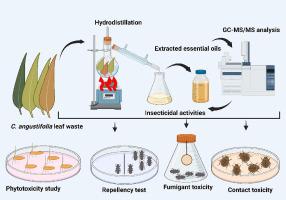当前位置:
X-MOL 学术
›
Saudi J. Biol. Sci.
›
论文详情
Our official English website, www.x-mol.net, welcomes your feedback! (Note: you will need to create a separate account there.)
Exploring the chemical characterization and insecticidal activities of Curcuma angustifolia roxb. leaf essential oils against three major stored product insects
Saudi Journal of Biological Sciences ( IF 4.4 ) Pub Date : 2024-04-05 , DOI: 10.1016/j.sjbs.2024.103986 Angel Paul , Naduvilthara U. Visakh , Berin Pathrose , Nicola Mori , Rowida S. Baeshen , Rady Shawer
Saudi Journal of Biological Sciences ( IF 4.4 ) Pub Date : 2024-04-05 , DOI: 10.1016/j.sjbs.2024.103986 Angel Paul , Naduvilthara U. Visakh , Berin Pathrose , Nicola Mori , Rowida S. Baeshen , Rady Shawer

|
Botanical pesticides are safe and widely used in pest management. belongs to the family Zingiberaceae and is a rhizomatous medicinal herb. Following rhizome harvesting, leaves are discarded as waste. However, they can be effectively utilized by extracting essential oils, which are potential biopesticides. The aim of the study is to evaluate the efficacy of the leaf essential oil of as a potential biopesticide against three stored grain pests, and by their contact, fumigant, and repellent activities. The leaves yield 0.39 ± 0.02 % of oil by hydrodistillation. GC–MS/MS characterization identified curzerenone (18.37 %), geranyl-p-cymene (17.32 %), α-elemenone (13.59 %), eucalyptol (7.58 %) as the main constituents. When exposed to different concentrations of oil, the test insect displayed noticeably high repellency rates. It also showed better contact toxicity at 24 h, LC = 0.22 mg/cm for cigarette beetle, LC = 0.64 mg/cm for red flour beetle, LC = 0.07 mg/cm for pulse beetle) and fumigation toxicities (LC = 10.8 mg/L air at 24 h, for cigarette, LC = 29.5 mg/L air for red flour beetle, LC = 7.9 mg/L air for pulse beetle). Additionally, a phytotoxicity study was done on paddy seeds, and the results showed no effect on seed germination or seedling growth. It was evident from this study that oil from waste leaves can be utilized as a botanical pesticide to manage the adults of these storage pests.
中文翻译:

探索姜黄的化学特性和杀虫活性。叶精油可对抗三种主要的储藏昆虫
植物源农药安全且广泛用于害虫防治。属于姜科,是一种根茎药草。根茎收获后,叶子被作为废物丢弃。然而,它们可以通过提取精油来有效利用,精油是潜在的生物农药。该研究的目的是评估叶精油作为潜在生物农药对抗三种储粮害虫的功效,以及它们的接触、熏蒸和驱避活性。通过水蒸馏,叶子可产出 0.39 ± 0.02 % 的油。 GC-MS/MS 表征确定姜黄素酮 (18.37 %)、香叶基-对伞花烃 (17.32 %)、α-榄香酮 (13.59 %)、桉油精 (7.58 %) 为主要成分。当暴露于不同浓度的油时,测试昆虫表现出明显高的驱避率。 24 h 时也表现出较好的接触毒性,烟甲虫的 LC = 0.22 mg/cm,红粉甲虫的 LC = 0.64 mg/cm,豆甲虫的 LC = 0.07 mg/cm)和熏蒸毒性(LC = 10.8 mg/cm)。 L 空气(24 小时),对于香烟,LC = 29.5 mg/L 空气(对于红粉甲虫),LC = 7.9 mg/L 空气(对于豆甲虫)。此外,对水稻种子进行了植物毒性研究,结果显示对种子发芽或幼苗生长没有影响。从这项研究中可以明显看出,废叶中的油可以用作植物源杀虫剂来控制这些储存害虫的成虫。
更新日期:2024-04-05
中文翻译:

探索姜黄的化学特性和杀虫活性。叶精油可对抗三种主要的储藏昆虫
植物源农药安全且广泛用于害虫防治。属于姜科,是一种根茎药草。根茎收获后,叶子被作为废物丢弃。然而,它们可以通过提取精油来有效利用,精油是潜在的生物农药。该研究的目的是评估叶精油作为潜在生物农药对抗三种储粮害虫的功效,以及它们的接触、熏蒸和驱避活性。通过水蒸馏,叶子可产出 0.39 ± 0.02 % 的油。 GC-MS/MS 表征确定姜黄素酮 (18.37 %)、香叶基-对伞花烃 (17.32 %)、α-榄香酮 (13.59 %)、桉油精 (7.58 %) 为主要成分。当暴露于不同浓度的油时,测试昆虫表现出明显高的驱避率。 24 h 时也表现出较好的接触毒性,烟甲虫的 LC = 0.22 mg/cm,红粉甲虫的 LC = 0.64 mg/cm,豆甲虫的 LC = 0.07 mg/cm)和熏蒸毒性(LC = 10.8 mg/cm)。 L 空气(24 小时),对于香烟,LC = 29.5 mg/L 空气(对于红粉甲虫),LC = 7.9 mg/L 空气(对于豆甲虫)。此外,对水稻种子进行了植物毒性研究,结果显示对种子发芽或幼苗生长没有影响。从这项研究中可以明显看出,废叶中的油可以用作植物源杀虫剂来控制这些储存害虫的成虫。



























 京公网安备 11010802027423号
京公网安备 11010802027423号